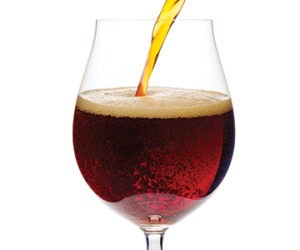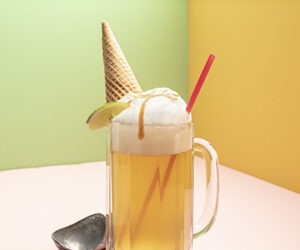Decoction Decoded: Tips From the Pros
Brewer: Ashleigh Carter, Bierstadt Lagerhaus in Denver, Colorado
The biggest upside to decoction mashing is drier beer. I believe it creates the elusive ‘malty without being sweet’ character and can simplify your malt bill. We are essentially a 3-malt brewery (with a few exceptions like acidulated malt used in our pale beers) but with just Pilsner, Vienna, and a single type of Munich malt you can make: Pils, helles, dunkel, bock, doppelbock, Oktoberfest, Vienna lager, export, Maibock, helles bock, etc . . .
Regarding all the time and effort that goes into the decoction process vs. step mashing — if I didn’t think it was worth it, then I wouldn’t do it. As a professional brewer with a brewhouse that was built for just the task it really doesn’t take that much more effort or time for me. And I like brewing; I like the process from start to finish. A brew day isn’t just a means to an end or something to get done with, it is part of the entire process. I can’t say it makes for “better” beer, but it does make for a different tasting beer; and I like that difference.
We follow the same basic mash profile for all of our beers. For Slow Pour Pils, we’ll single decoct, mashing in at 131 °F (55 °C) for 10 minutes, then raising to 144 °F (62 °C) for 40 minutes, then up to 160 °F (71 °C) for 30 minutes, and then a mash off decoction (10 min.). All of our other beers undergo a double decoction with the same temperature profile, but we’ll pull off 1⁄3 to decoct after beta-amylase rest and use that to bring the mash temp up to 160 °F (71 °C) (it is important to rest the decoction portion at the 160 °F (71 °C) mash temp before bringing it to boil) and let it rest for 20 more minutes before the second mash off decoction. For pale beers we boil the decoctions for 10 minutes and on darker beers we boil the decoctions for 20 minutes to try and get a little more color pick up from the boil without adding a ton of dark malts.
When talking about base malt, it is important to pick a base malt appropriate for the style (Munich malt for dunkel/Oktoberfest, Pilsner malt for helles and Pils, etc . . .) but when you are talking about supporting malts like melanoidin/caramel/crystal malts, these are not great substitutes for decoction – most are not very fermentable which can leave you with a sweet beer, and in too large of quantities they negatively impact the flavor.
When actually performing a decoction mash, the mash should be very thin to begin with. Think 1.9–2.2 quarts strike water per lb. (4–4.5 L/kg grains). In some ways this is where the homebrewer has more control than the professional because you can grab the thicker stuff for the first decoctions and the very liquidy stuff for the final decoction. Some of it is guesswork, but no matter what it should be thin enough that while you are boiling it you’re not evaporating/caramelizing too much.
My favorite style to utilize a decoction mash is helles. People are surprised that we double decoct ours and it is still pale in color. Decoction helps to develop the rich malt character that helles is known for without leaving residual sweetness.
Brewer: Steve Holle, Kansas City Bier Company in Kansas City, Missouri
Obviously we think decoction is well worth the time and effort. Two of the best examples of Bavarian helles I have had are from Andechs and Augustiner. I have toured both breweries, and both use decoction mashing. They also ferment cold, use separate fermentation and lagering tanks, naturally carbonate, and use German malt and hops. Any one of these techniques on its own is probably not especially noticeable, but quality is usually the sum of minor incremental steps that in total produce a great effect.
Here at Kansas City Bier Company, we generally use a classic German step mashing in the following sequence: 144–162–169 °F (62–72–76 °C) with various small modifications depending on the beer. Nearly all of our beers are decocted, and a few are double or even triple decocted. The specific decoction technique to increase the mash temperature varies from beer to beer.
In theory, the thickest portion of the mash is boiled to have the greatest degradation of starch while protecting the higher concentration of enzymes in the main mash. The Handbook of Basic Brewing Calculations by the Master Brewers Association of America (MBAA) provides calculations for splitting the mash to gain desired mash rest temperatures. But the important point is to always add the smaller decoction volume back to the mash in increments. Start with a decoction volume of 1⁄4 to 1⁄3 and after each addition of the decoction back to the main mash, check the temperature. When the main mash reaches the desired temperature, do not add any more of the decoction back to the main mash until the decoction has cooled to the same temperature as the main mash.
The effects of a single decoction on our Helles (1.050 OG, 22 IBU, 95% Pils, 5% Vienna malt) produce an intangible depth of character with the bread and honey malt flavors. Few brewers describe their normal gravity, golden-colored lager as malty. The combination of German malts and decoction mashing create a golden lager that I like to describe as rich, velvety, round, and complex. That’s what decoction does — in subtle ways.





